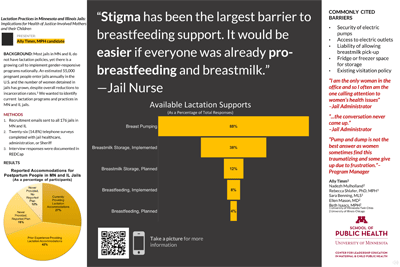Ally Timm
MPH, Maternal & Child Health
Co-Authors:
Nadezh Mulholland, Rebecca Shlafer, Sara Benning, Ellen Mason
Advisor:
Dr. Rebecca Shlafer
Educational Objectives:
- Discuss the impacts of maternal incarceration on breastfeeding and breastmilk availability and subsequent influences on maternal and child health.
- Identify lactation accommodations in Minnesota and Illinois jails.
- Describe potential best practices for lactation accommodations in carceral settings including pumping, storage, and breastfeeding.
Keywords:
Lactation, Incarceration
Abstract
Background: Women have distinct healthcare needs that jails are not designed to accommodate. Jails,intended to detain people pre-trial and for short-term sentences, have a unique role in supporting postpartum health, especially for lactating women. In recent years, multiple state prisons have adopted lactation policies to support lactation. However, the full extent of lactation practices is unknown, particularly in county jails.
Methods: Minnesota and Illinois county jails were recruited through email. Requests for participation were sent to medical staff or jail administrators. When neither was responsive, Sheriffs were contacted directly. Follow-up emails were sent two weeks after initial contact. Participants completed a phone survey about lactation programming and postpartum health; responses were documented in REDCap.
Results: Emails were sent to 82 Minnesota jails and 91 Illinois jails; we received 47 replies, with 24 (13.9%) total interviews. Four facilities reported having a written lactation policy and 17 reported currently or previously providing accommodations for lactating women. Of the 7 facilities that reported no experience with lactation, 71.4% reported a plan for supporting lactation if the situation arose.
Conclusions: Preliminary evidence demonstrates that county jails have been providing some lactation accommodations. Given the known health benefits of breastmilk for maternal and child health (MCH), efforts towards contact visits that permit breastfeeding and milk storage are warranted. Interviews have not been finished; we anticipate that our response rate (13.9%) may be a limitation to our final analysis.
Support
The Center for Leadership Education in Maternal and Child Public Health is supported by the Health Resources and Services Administration (HRSA) of the U.S. Department of Health and Human Services (HHS) under grant number T76MC00005-59-00 for Leadership Education in Maternal and Child Public Health in the amount of $1,750,000. This information or content and conclusions of our outreach products are those of the authors and should not be construed as the official position or policy of, nor should any endorsements be inferred by HRSA, HHS or the U.S. Government.

View Poster (PPSX)
